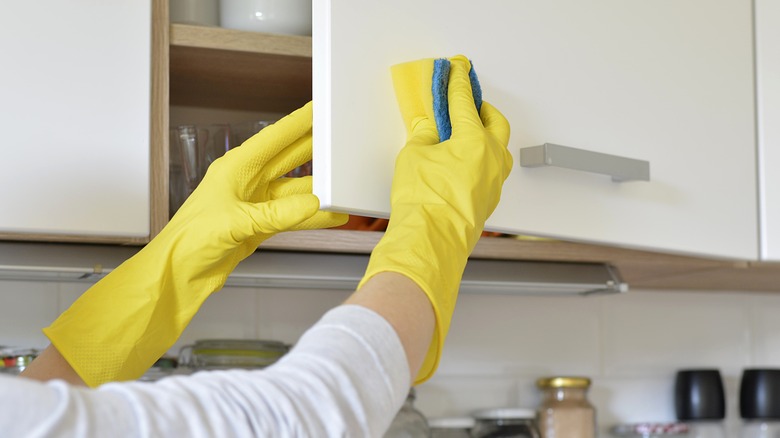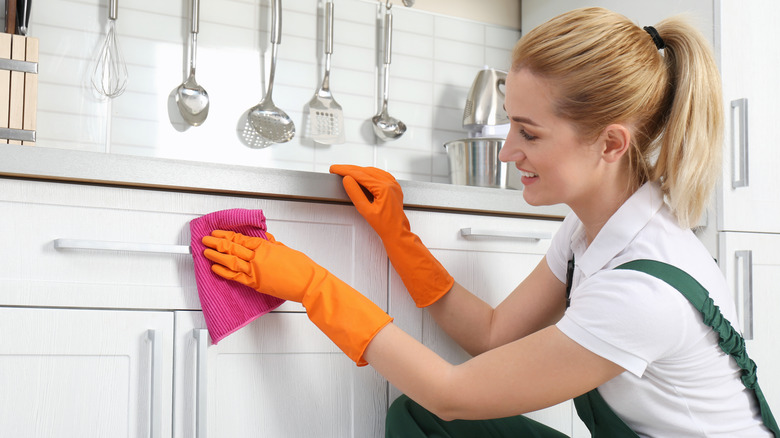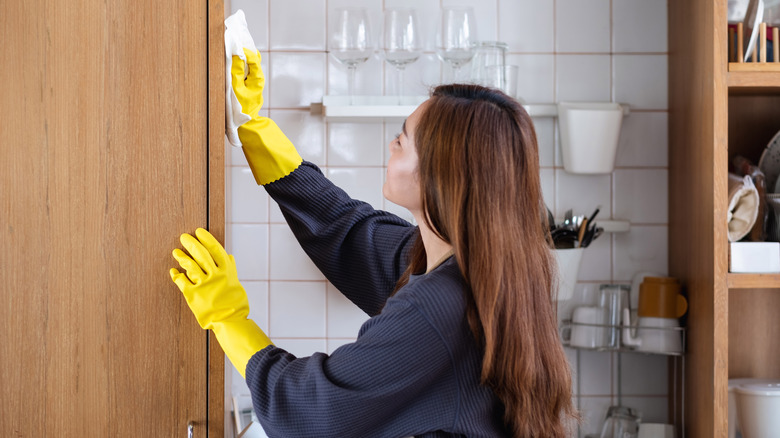Is It Safe To Use Hydrogen Peroxide To Clean Kitchen Cabinets?
If you have ever opened your kitchen cupboard and noticed it was looking a little grimy, you may be searching for ways to make both the inside and outside gleam once more. Not only is it prudent to do a food clear-out but wiping down your cabinets thoroughly will prevent germs and ants from getting in. Among the surprising ways to use hydrogen peroxide is as a popular alternative to using typical cleaners. You may be wondering if it's safe to use the chemical that way in cupboards. The answer is yes but only if you observe some precautions. If used incorrectly, the alternative cleaning agent can quickly become unsafe.
The safety of hydrogen peroxide depends on factors like its strength (certain types of the chemical go up to 35%), how you ventilate a room when using it, and how you use it in general. Though not inherently dangerous by itself, like any product, hydrogen peroxide can become harmful if you aren't using it properly. Once you know the best way to use it, it's an effective cleaner.
What to avoid when cleaning with hydrogen peroxide
Speaking to the Cleveland Clinic, physician Sarah Pickering Beers, MD, explained why hydrogen peroxide is an effective cleaner. "Peroxide kills bacteria, fungi, and viruses," Beers stated. "It can come in handy if you don't have disinfecting wipes or bleach. Just be careful not to get it on your clothes or furniture, or it may bleach them." As far as tips for cleaning your kitchen cabinets go, there are a few things you need to know. Firstly, never mix hydrogen peroxide with vinegar. Vinegar is another popular natural ingredient to clean with but when combined with hydrogen peroxide, it creates a substance called peracetic acid.
This can irritate the skin and eyes and develop into something more serious if inhaled in large amounts. Don't take the risk of even using one product after the other. Secondly, always wear gloves. This is especially important if you have allergies or sensitive skin. Even at a concentration of 3%, hydrogen peroxide can irritate the skin. You should also wash your hands thoroughly before and after cleaning with hydrogen peroxide.
Get your cabinets sparkling
Now you know what not to do with hydrogen peroxide, here's what you should do. Before you begin, empty the cupboards of all items. You should not use hydrogen peroxide in a cabinet with fresh or open food. Instead, use it for cabinets where you store crockery or food enclosed in packaging. Next, put on your gloves and pour a small amount (or spritz if you have the spray version) onto a soft microfiber cloth. Remember that 3% is the highest percentage you should be using for cleaning purposes, so double-check the bottle before starting.
Clean your cabinet until all marks and dust have disappeared and then go in for a second time with another slightly damp cloth to remove any trace of the hydrogen peroxide. We recommend leaving your cupboards open for a few hours with your kitchen windows also open. This will reduce the risk of inhaling any leftover chemical fumes. Only put the items back in the cupboard once you're fully sure the scent has gone. One last thing to keep in mind is that hydrogen peroxide will bleach, so if you're using it on darker wood cabinets, spot test before going all in and potentially causing discoloration.


